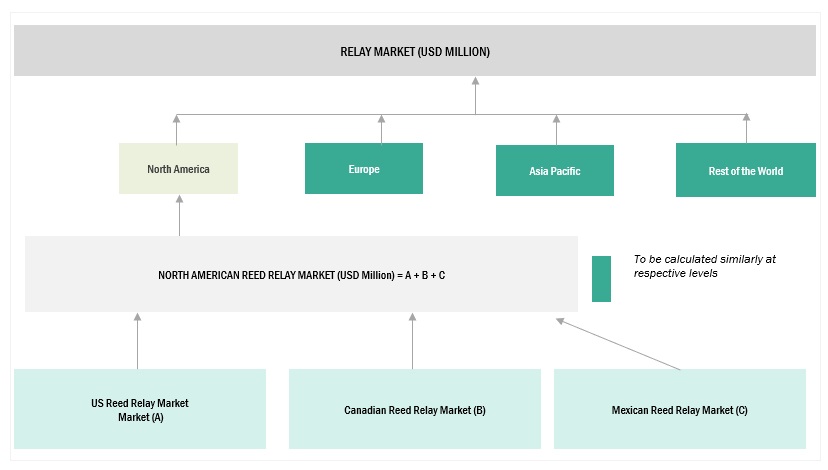The global relay market size is estimated to be USD 9.0 billion in 2022 and is projected to reach USD 14.7 billion by 2030, at a CAGR of 6.3% during the forecast period. The relay market is driven by the rising investments in renewable energy resources. According to the International Energy Agency (IEA) forecast, the total global renewable capacity is expected to increase by 1,220 GW between 2019 and 2024, with solar accounting for about 60% of the total additions. IEA also projects that an additional 314 GW could potentially be added under the accelerated scenario during the same period. IEA defines an accelerated case as a scenario wherein governments address three main challenges preventing faster deployment: policy and regulatory uncertainty, high investment risks in developing countries, and system integration of wind and solar in some countries. These increased capacity additions require proper grid infrastructure equipped with protective relays to evacuate power reliably to the distribution utilities.
Increasing power demand and investments in smart grid infrastructure are likely to bring opportunities for relay distributors. All major utilities around the world have announced investments in smart grid infrastructure. These investments aim to improve grid monitoring and control through extensive data collection, peer to peer communication between intelligent electronic devices, and remote operation of grid elements. Numerical relays possess the ability to collect voltage, current, and other real time grid parameters. They can also store, analyze, and act according to the pre-set trip settings. Due to these features and relatively low-cost, numerical relays are installed as part of grid automation and digitization projects. These increased investments in smart grid infrastructure present immense growth opportunity to the global relay market.
Key Market Players
Key Players include Panasonic Corporation (Japan), Xiamen Hongfa Electroacoustic Co., Ltd. (China), TE connectivity (Switzerland), Fuji Electric (Japan), and OMRON Industrial Automation (Japan).
Download PDF Brochure: https://www.marketsandmarkets.com/pdfdownloadNew.asp?id=58206549
In 2021, the Asia Pacific dominated the global relay market, followed by Europe and North America.
The APAC region, by country, has been segmented into China, India, Japan, and the Rest of APAC. Japan is increasingly focusing on increasing the share of renewables in power generation. According to the Government of Japan, the country aims to double its solar and wind generation capacity to between 127.1 gigawatts and 141.2 gigawatts by fiscal 2030. Apart from this, Japan’s market for medical devices is amongst the world’s largest. Data from Japan’s Ministry of Health, Labor and Welfare (MHLW) show that the Japanese market for medical devices in 2020 was about USD 38 billion. This presents ample opportunities for the growth of the relay market in the country and in the region, as a whole.

Reed type of relay is expected to be the fastest growing segment of the relay market, growing at a CAGR of 16.0%. The major factors driving the market’s growth are the increasing demand for reed relays in security systems, telecom equipment, process control systems, automatic test equipment, and electronic instrumentation. In addition, the rising adoption of reed relays in security systems and telecom equipment is another factor fueling the market growth. Moreover, the growing trend of miniaturization and automation is also contributing to market growth.
The low voltage segment is projected to be the largest segment of the relay market. The increasing focus on residential and commercial activities will drive the long-term growth of this segment all over the world, particularly in Asia Pacific. The demand for modern intelligent controllers for motor protection is also expected to rise, which would drive market growth. Combined protection of integrated relays and circuit breakers is also expected to boost the development of the global relay market. Furthermore, the increasing adoption of automobiles in the growing economies of APAC is also expected to boost the demand.
PCB mounting type is projected to be the fastest growing segment of the relay market, growing at a CAGR of 7.5%. PCBs are essential since they offer rigid support to hold components in place, electrical connections between components, and a compact package that may be integrated into a product. PCB is mostly used in various types of application industries such as LED, smartphones, computers, automotive, aerospace, maritime equipment, and many more. PCBs are also high in demand in the industrial and medical industries. This is because a wide range of devices, such as surgical equipment, cardiac monitors, and communication systems, use PCBs. Smart devices and growing consumer demand for consumer electronics are the main drivers for the growth of the printed circuit board mounting type relay market.
Ask Sample Pages: https://www.marketsandmarkets.com/pdfdownloadNew.asp?id=58206549
Asia Pacific is expected to grow at the highest CAGR during the forecast period. China accounted for the maximum share of the Asia Pacific market in 2021. India is projected to grow at the highest CAGR from 2022 to 2030. The market is expected to grow due to the increasing demand for energy and raw materials in the manufacturing sector, which will lead to increased production of metals, chemicals, and paper. Thus, with the growing focus on manufacturing and the increasing expenditure on energy infrastructure, the Asia Pacific Global relay market is poised to witness significant growth and is expected to outpace other regions.

